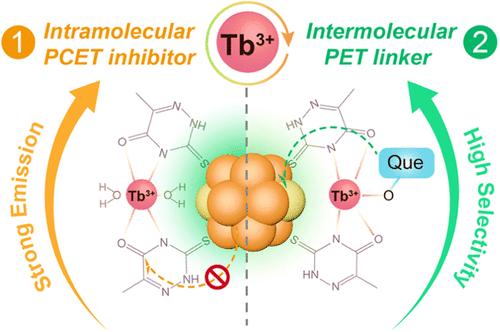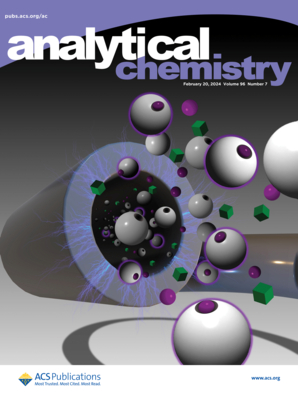Dual-Function Strategy for Enhanced Quercetin Detection Using Terbium(III) Ion-Bound Gold Nanoclusters
IF 6.7
1区 化学
Q1 CHEMISTRY, ANALYTICAL
引用次数: 0
Abstract
The engineering of metal nanoclusters (NCs) that exhibit bright emissions and high sensing performance under physiological conditions is still a formidable challenge. In this study, we report a novel design strategy for realizing excellent performance metal NC-based probes by leveraging both concerted proton-coupled electron transfer (PCET) and photoinduced electron transfer (PET) mechanisms, with terbium(III) (Tb3+) ions serving as a key modulator. Our findings indicate that the binding of Tb3+ ions to the 6-aza-2-thiothymidine (ATT) ligand effectively inhibits the proton-transfer step in the concerted PCET pathway of Au10(ATT)6 NCs, giving rise to over a 10-fold enhancement in fluorescence and a quantum yield of 7.2%. Moreover, the capped Tb3+ ions on the surface of Au10(ATT)6 NCs can act as a bridge to facilitate an efficient donor-linker-acceptor type PET reaction from quercetin (Que) to the excited Au10 core by specifically interacting with the bare 3-OH group. These advancements enable the Tb3+/Au10(ATT)6 NC-based probe to achieve a significantly lower limit of detection for Que, reduced by nearly 3 orders of magnitude to 2.6 nM, while also addressing the critical difficulty of selectively detecting Que in the presence of its glycosylated analogues. This work opens new opportunities for the precise control of photoluminescence in metal NC probes at the molecular level, potentially promoting the development of next-generation metal NC-based sensing technologies.

利用铽(III)离子结合金纳米团簇增强槲皮素检测的双功能策略
金属纳米团簇(NCs)在生理条件下表现出明亮的发射和高传感性能仍然是一个巨大的挑战。在这项研究中,我们报告了一种新的设计策略,利用协同质子耦合电子转移(PCET)和光诱导电子转移(PET)机制,以铽(III) (Tb3+)离子作为关键调制器,实现了性能优异的金属纳米基探针。我们的研究结果表明,Tb3+离子与6-偶氮-2-硫thymidine (ATT)配体的结合有效地抑制了Au10(ATT)6 NCs协同PCET途径中的质子转移步骤,导致荧光增强10倍以上,量子产率为7.2%。此外,Au10(ATT)6 NCs表面的Tb3+离子可以作为一个桥梁,通过特异性地与裸3-OH基团相互作用,促进槲皮素(Que)与激发的Au10核之间有效的供体-连接体-受体型PET反应。这些进步使基于Tb3+/Au10(ATT)6 nc的探针能够实现对Que的检测下限显着降低,降低了近3个数量级至2.6 nM,同时也解决了在其糖基化类似物存在下选择性检测Que的关键困难。这项工作为在分子水平上精确控制金属NC探针的光致发光开辟了新的机会,有可能促进下一代金属NC传感技术的发展。
本文章由计算机程序翻译,如有差异,请以英文原文为准。
求助全文
约1分钟内获得全文
求助全文
来源期刊

Analytical Chemistry
化学-分析化学
CiteScore
12.10
自引率
12.20%
发文量
1949
审稿时长
1.4 months
期刊介绍:
Analytical Chemistry, a peer-reviewed research journal, focuses on disseminating new and original knowledge across all branches of analytical chemistry. Fundamental articles may explore general principles of chemical measurement science and need not directly address existing or potential analytical methodology. They can be entirely theoretical or report experimental results. Contributions may cover various phases of analytical operations, including sampling, bioanalysis, electrochemistry, mass spectrometry, microscale and nanoscale systems, environmental analysis, separations, spectroscopy, chemical reactions and selectivity, instrumentation, imaging, surface analysis, and data processing. Papers discussing known analytical methods should present a significant, original application of the method, a notable improvement, or results on an important analyte.
 求助内容:
求助内容: 应助结果提醒方式:
应助结果提醒方式:


